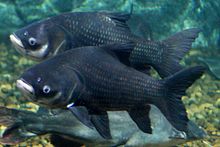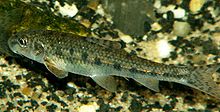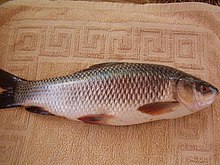Cyprinidae
The cyprinids or carp (Cyprinidae) are a family of physostomous teleost fish, almost all freshwater although some species can be found in estuaries, distributed by rivers in Africa, Eurasia and North America (from northern Canada to southern Mexico). Its name comes from the Greek kyprinos, which means 'golden fish'.
They first appear in the fossil record in the Eocene, during the Lower Tertiary.
Morphology
They have between one and three rows of teeth in the pharynx, with a maximum of eight teeth per row; normally the mouth has thin lips without papillae, sometimes it is a sucking mouth —in the genera Garra and Labeo—, with or without whiskers; upper jaw normally protusible; the dorsal fin in some species has spiny rays.
The primitive number of chromosomes is fifty in almost all species—some with forty-eight—but cases of polyploidy occur.
The maximum length described has been about 3 m in Catlocarpio siamensis, although there are many species that do not exceed 5 cm.
Habitat and way of life
They are oviparous fish that abandon their spawn, although in some species the males build nests and/or protect the eggs.
They have a varied diet, although many are insectivores, feeding especially on mosquitoes.
Importance to humans
Many are fished as an important source of human food, being raised in aquaculture ponds for this purpose. A very popular variety in aquariums is the golden carp, of Chinese origin.
Systematics
It is a large family as there are more than two thousand species grouped into more than two hundred genera:
- Aaptosyax (Rainboth, 1991)
- Abbottina (Jordan y Fowler, 1903)
- Abramis (Cuvier, 1816), bremas comunes
- Acanthalburnus (Berg, 1916)
- Acanthobrama (Heckel, 1843)
- Acanthogobio (Herzenstein, 1892)
- Acanthorhodeus (Bleeker, 1871)
- Acapoeta (Cockerell, 1910)
- Acheilognathus (Bleeker, 1860)
- Achondrostoma (Robalo, Almada, Levy y Doadrio 2006)
- Acrocheilus (Agassiz, 1855)
- Acrossocheilus (Oshima, 1919)
- Agosia (Girard, 1856)
- Albulichthys (Bleeker, 1860)
- Alburnoides (Jeitteles, 1861)
- Alburnus (Rafinesque, 1820), alburnos
- Algansea (Girard, 1856)
- Amblypharyngodon (Bleeker, 186)
- Amblyrhynchichthys (Bleeker, 1860)
- Anabarilius (Cockerell, 1923)
- Anaecypris (Collares-Pereira, 1983), jarabugo
- Ancherythroculter (Yih y Wu, 1964)
- Aphyocypris (Günther, 1868)
- Aspidoparia (Heckel, 1847)
- Aspiolucius (Berg, 1907)
- Aspiorhynchus (Kessler, 187)
- Aspius (Agassiz, 1832)
- Atrilinea (Chu, 1935)
- Aulopyge (Heckel, 1841)
- Aztecula (Jordan y Evermann, 1898), carpita azteca
- Balantiocheilos (Bleeker, 1860)
- Bangana (Hamilton, 1822)
- Barbichthys (Bleeker, 1860)
- Barbodes (Bleeker, 1859)
- Barboides (Brüning, 1929)
- Barbonymus (Kottelat, 1999)
- Barbopsis (Di Caporiacco, 1926)
- Barbus (Cuvier y Cloquet, 1816), barbos comunes
- Barilius (Hamilton, 1822)
- Belligobio (Jordan & Hubbs, 1925)
- Bengala (Gray, 1833)
- Biwia (Jordan & Fowler, 1903)
- Blicca (Heckel, 1843), brema blanca
- Boraras (Kottelat & Vidthayanon, 1993)
- Brevibora T. Y. Liao, S. O. Kullander & F. Fang, 2010
- Caecobarbus (Boulenger, 1921)
- Caecocypris (Banister y Bunni, 1980)
- Campostoma (Agassiz, 1855), rodapiedras
- Candidia (Jordan & Richardson, 1909)
- Capoeta (Valenciennes, 1842)
- Capoetobrama (Berg, 1916)
- Carasobarbus (Karaman, 1971)
- Carassioides (Oshima, 1926)
- Carassius (Nilsson, 1832)
- Catlocarpio (Boulenger, 1898)
- Chagunius (Smith, 1938)
- Chalcalburnus (Berg, 1933)
- Chanodichthys (Bleeker, 1860)
- Chela (Hamilton, 1822)
- Chelaethiops (Boulenger, 1899)
- Chondrostoma (Agassiz, 1832)
- Chuanchia (Herzenstein, 1891)
- Cirrhinus (Oken, 1817)
- Clinostomus (Girard, 1856)
- Coptostomabarbus (David & Poll, 1937)
- Coreius (Jordan & Starks, 1905)
- Coreoleuciscus (Mori, 1935)
- Cosmochilus (Sauvage, 1878)
- Couesius (Jordan, 1878)
- Crossocheilus (Kuhl y van Hasselt, 1823)
- Ctenopharyngodon (Steindachner, 1866)
- Culter (Basilewsky, 1855)
- Cultrichthys (Smith, 1938)
- Cyclocheilichthys (Bleeker, 1859)
- Cyprinella (Girard, 1856)
- Cyprinion (Heckel, 1843)
- Cyprinus (Linnaeus, 1758), carpas comunes
- Danio (Hamilton, 1822)
- Danionella (Roberts, 1986)
- Devario (Heckel, 1843)
- Dionda (Girard, 1856)
- Diptychus (Steindachner, 1866)
- Discherodontus (Rainboth, 1989)
- Discocheilus (Zhang, 1997)
- Discogobio (Lin, 1931)
- Discolabeo (Fowler, 1937)
- Distoechodon (Peters, 1881)
- Eirmotus (Schultz, 1959)
- Elopichthys (Bleeker, 1860)
- Engraulicypris (Günther, 1894)
- Epalzeorhynchos (Bleeker, 1855)
- Eremichthys (Hubbs y Miller, 1948)
- Erimonax (Jordan, 1924)
- Erimystax (Jordan, 1882)
- Erythroculter (Berg, 1909)
- Esomus (Swainson, 1839)
- Evarra (Woolman, 1894)
- Exoglossum (Rafinesque, 1818)
- Garra (Hamilton, 1822)
- Gibelion (Heckel, 1843)
- Gila (Baird y Girard, 1853)
- Gnathopogon (Bleeker, 1860)
- Gobio (Cuvier, 1816), gobios
- Gobiobotia (Kreyenberg, 1911)
- Gobiocypris (Ye y Fu, 1983)
- Gymnocypris (Günther, 1868)
- Gymnodanio (Chen y He, 1992)
- Gymnodiptychus (Herzenstein, 1892)
- Gymnostomus (Heckel, 1843)
- Hainania (Koller, 1927)
- Hampala (Kuhl & van Hasselt, 1823)
- Hemibarbus (Bleeker, 1860)
- Hemiculter (Bleeker, 1860)
- Hemiculterella (Warpachowski, 1887)
- Hemigrammocapoeta (Pellegrin, 1927)
- Hemigrammocypris (Fowler, 1910)
- Hemitremia (Cope, 1870)
- Henicorhynchus (Smith, 1945)
- Herzensteinia (Chu, 1935)
- Hesperoleucus (Snyder, 1913)
- Horadandia (Deraniyagala, 1943)
- Horalabiosa (Silas, 1954)
- Huigobio (Fang, 1938)
- Hybognathus (Agassiz, 1855)
- Hybopsis (Agassiz, 1854)
- Hypophthalmichthys (Bleeker, 1860)
- Hypselobarbus (Bleeker, 1860)
- Hypsibarbus (Rainboth, 1996)
- Iberochondrostoma (Robalo, Almada, Levy y Doadrio, 2006)
- Inlecypris (Howes, 1980)
- Iotichthys (Jordan y Evermann, 1896)
- Iranocypris (Bruun y Kaiser, 1944)
- Ischikauia (Jordan y Snyder, 1900)
- Kalimantania (Banarescu, 1980)
- Kosswigobarbus (Karaman, 1971)
- Labeo (Cuvier, 1816)
- Labeobarbus (Rüppell, 1835)
- Labiobarbus (van Hasselt, 1823)
- Ladigesocypris (Karaman, 1972)
- Ladislavia (Dybowski, 1869)
- Lagowskiella (Dybowski, 1916)
- Laocypris (Kottelat, 2000)
- Lavinia (Girard, 1854)
- Lepidomeda (Cope, 1874)
- Lepidopygopsis (Raj, 1941)
- Leptobarbus (Bleeker, 1860)
- Leptocypris (Boulenger, 1900)
- Leucalburnus (Berg, 1916)
- Leucaspius (Heckel y Kner, 1858)
- Leuciscus (Cuvier, 1816)
- Linichthys (Zhang y Fang, 2005)
- Lissochilus'' (Weber y de Beaufort, 1916)
- Lobocheilos (Bleeker, 1853)
- Longiculter (Fowler, 1937)
- Luciobrama (Bleeker, 1870)
- Luciocyprinus (Vaillant, 1904)
- Luciosoma (Bleeker, 1855)
- Luxilus (Rafinesque, 1820)
- Lythrurus (Jordan, 1876)
- Macrhybopsis (Cockerell y Allison, 1909)
- Macrochirichthys (Bleeker, 1860)
- Margariscus (Cockerell, 1909)
- Meda (Girard, 1856)
- Megalobrama (Dybowski, 1872)
- Mekongina (Fowler, 1937)
- Mesobola (Howes, 1984)
- Mesogobio (Banarescu y Nalbant, 1973)
- Mesopotamichthys (Karaman, 1971)
- Metzia (Jordan y Thompson, 1914)
- Microphysogobio (Mori, 1934)
- Microrasbora (Annandale, 1918)
- Moapa (Hubbs y Miller, 1948)
- Mylocheilus (Agassiz, 1855)
- Mylopharodon (Ayres, 1855)
- Mylopharyngodon (Peters, 1881)
- Mystacoleucus (Günther, 1868)
- Naziritor (Mirza y Javed, 1985)
- Nematabramis (Boulenger, 1894)
- Neobarynotus (Banarescu, 1980)
- Neobola (Vinciguerra, 1895)
- Neolissochilus (Rainboth, 1985)
- Nicholsicypris (Chu, 1935)
- Nocomis (Girard, 1856)
- Notemigonus (Rafinesque, 1819)
- Notropis (Rafinesque, 1818)
- Ochetobius (Günther, 1868)
- Onychostoma (Günther, 1896)
- Opsaridium (Peters, 1854)
- Opsariichthys (Bleeker, 1863)
- Opsarius (McClelland, 1839)
- Opsopoeodus (Hay, 1881)
- Oregonichthys (Hubbs, 1929)
- Oreichthys (Smith, 1933)
- Oreoleuciscus (Warpachowski, 1889)
- Orthodon (Girard, 1856)
- Osteobrama (Heckel, 1843)
- Osteochilichthys (Hora, 1942)
- Osteochilus (Günther, 1868)
- Oxygaster (van Hasselt, 1823)
- Oxygymnocypris (Tsao, 1964)
- Pachychilon (Steindachner, 1882)
- Paedocypris (Kottelat, Britz, Tan y Witte, 2005)
- Parabramis (Bleeker, 1865)
- Paracanthobrama (Bleeker, 1865)
- Parachela (Steindachner, 1881)
- Paracrossochilus (Popta, 1904)
- Paralaubuca (Bleeker, 1865)
- Paraleucogobio (Berg, 1907)
- Parapsilorhynchus (Hora, 1921)
- Pararhinichthys (Stauffer, Hocutt y Mayden, 1997)
- Parasikukia (Doi, 2000)
- Parasinilabeo (Wu, 1939)
- Paraspinibarbus (Chu y Kottelat, 1989)
- Parasqualidus (Doi, 2000)
- Parazacco (Chen, 1982)
- Pectenocypris (Kottelat, 1982)
- Pelecus (Agassiz, 1835)
- Percocypris (Chu, 1935)
- Petroleuciscus (Bogutskaya, 2002)
- Phenacobius (Cope, 1867)
- Phoxinellus (Heckel, 1843)
- Phoxinus (Rafinesque, 1820)
- Phreatichthys (Vinciguerra, 1924)
- Pimephales (Rafinesque, 1820)
- Placocheilus (Wu, 1977)
- Plagiognathops (Berg, 1907)
- Plagopterus (Cope, 1874)
- Platygobio (Gill, 1863)
- Platypharodon (Herzenstein, 1891)
- Platysmacheilus (Lu, Luo & Chen, 1977)
- Pogobrama (Luo, 1995)
- Pogonichthys (Girard, 1854)
- Poropuntius (Smith, 1931)
- Probarbus (Sauvage, 1880)
- Procypris (Lin, 1933)
- Prolabeo (Norman, 1932)
- Prolabeops (Schultz, 1941)
- Pseudaspius (Dybowski, 1869)
- Pseudobarbus (Smith, 1841)
- Pseudobrama (Bleeker, 1870)
- Pseudochondrostoma'' (Robalo, V. C. Almada, Levy & Doadrio, 2007)
- Pseudogobio (Bleeker, 1860)
- Pseudohemiculter (Nichols y Pope, 1927)
- Pseudolaubuca (Bleeker, 1865)
- Pseudophoxinus (Bleeker, 1860)
- Pseudopungtungia (Mori, 1935)
- Pseudorasbora (Bleeker, 1860)
- Pteronotropis (Fowler, 1935)
- Ptychidio (Myers, 1930)
- Ptychobarbus (Steindachner, 1866)
- Ptychocheilus (Agassiz, 1855)
- Pungtungia (Herzenstein, 1892)
- Puntioplites (Smith, 1929)
- Puntius (Hamilton, 1822)
- Qianlabeo (Zhang & Chen, 2004)
- Raiamas (Jordan, 1919)
- Rasbora (Bleeker, 1859)
- Rasborichthys (Bleeker, 1860)
- Rasborinus (Oshima, 1920)
- Rastrineobola (Fowler, 1936)
- Rectoris (Lin, 1935)
- Relictus (Hubbs & Miller, 1972)
- Rhinichthys (Agassiz, 1849)
- Rhinogobio (Bleeker, 1870)
- Rhodeus (Agassiz, 1832)
- Richardsonius (Girard, 1856)
- Rohtee (Sykes, 1839)
- Rohteichthys (Bleeker, 1860)
- Romanogobio (Banarescu, 1961)
- Rostrogobio (Taranetz, 1937)
- Rutilus (Rafinesque, 1820), rutilos
- Salmostoma (Swainson, 1839)
- Sanagia (Holly, 1926)
- Sarcocheilichthys (Bleeker, 1860)
- Saurogobio (Bleeker, 1870)
- Sawbwa (Annandale, 1918)
- Scaphiodonichthys (Vinciguerra, 1890)
- Scaphognathops (Smith, 1945)
- Scardinius (Bonaparte, 1837)
- Schismatorhynchos (Bleeker, 1855)
- Schizocypris (Regan, 1914)
- Schizopyge (Heckel, 1847)
- Schizopygopsis (Steindachner, 1866)
- Schizothorax (Heckel, 1838)
- Securicula (Günther, 1868)
- Semilabeo (Peters, 1881)
- Semiplotus (Bleeker, 1860)
- Semotilus (Rafinesque, 1820)
- Sikukia (Smith, 1931)
- Sinibrama (Wu, 1939)
- Sinilabeo (Rendahl, 1932)
- Sinocrossocheilus (Wu, 1977)
- Sinocyclocheilus (Fang, 1936)
- Snyderichthys (Miller, 1945)
- Spinibarbus (Oshima, 1919)
- Squalidus (Dybowski, 1872)
- Squaliobarbus (Günther, 1868)
- Squalius (Bonaparte, 1837)
- Stypodon (Garman, 1881)
- Sundadanio (Kottelat y Witte, 1999)
- Tampichthys (Schönhuth, Doadrio, Dominguez-Dominguez, Hillis y Mayden, 2008)
- Tanakia (Jordan & Thompson, 1914)
- Tanichthys (Lin, 1932)
- Telestes (Bonaparte, 1837)
- Thryssocypris (Roberts & Kottelat, 1984)
- Thynnichthys (Bleeker, 1860)
- Tinca (Cuvier, 1816), tencas
- Tor (Gray, 1834)
- Toxabramis (Günther, 1873)
- Tribolodon (Sauvage, 1883)
- Trigonostigma (Kottelat & Witte, 1999)
- Troglocyclocheilus (Kottelat & Bréhier, 1999)
- Tropidophoxinellus (Stephanidis, 1974)
- Typhlobarbus (Chu & Chen, 1982)
- Typhlogarra (Trewavas, 1955)
- Varicorhinus (Rüppell, 1835)
- Vimba (Fitzinger, 1873)
- Xenobarbus (Norman, 1923)
- Xenocyprioides (Chen, 1982)
- Xenocypris (Günther, 1868)
- Xenophysogobio (Chen y Cao, 1977)
- Yaoshanicus (Lin, 1931)
- Yuriria (Jordan y Evermann, 1896)
- Zacco (Jordan y Evermann, 1902)
Family Cyprinidae incertae sedis:
- Alburnus harusini (Herzenstein, 1889)
- Alburnus nordmannii (Dybowski, 1862)
- Alburnus oleiferus (Dabry de Thiersant, 1872)
- Alburnus vignoni (Lortet, 1883)
- Aspius alburnus (Bonaparte, 1841)
- Barbodes baoulan (Herre, 1926)
- Barbodes clemensi (Herre, 1924)
- Barbodes palata (Herre, 1924)
- Barbodes behind (Herre, 1926)
Contenido relacionado
Spinal nerve
Marine biology
Avenula blaui













